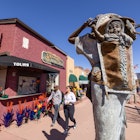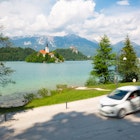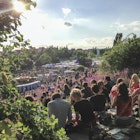A trip to the historic lands of Judea and Samaria – the modern-day West Bank – is like walking through pages of the Bible.
This small chunk of land in the highlands of the Levant is where Jesus started his ministry, where Abraham staked his claim on the land and where King Solomon lolled in his tent by shimmering pools of spring water. 'Bible Tourism' here is the real deal, where places mentioned in the Holy Scriptures can be visited, contemplated and honoured.
Bethlehem is a fine place to begin a tour of the West Bank’s holy sites. It was here that Joseph and Mary visited for a census and went home with a son. The birth of Jesus is commemorated at the Church of the Nativity, the world’s oldest continuously operating church. One cannot help but bow through the appropriately named the Door of Humility, only about one-and-a-half metres high. The raison d’etre of the church is to protect the Grotto of the Nativity, a cramped, candlelit nook believed to be the spot where Jesus entered the world. A 14-point star placed on the ground marks the auspicious spot.
Weave through the busy Bethlehem streets to the neighbouring village of Beit Sahour, home to the Biblical field where shepherds watched their flocks by night. As the Bible tells it, an angel appeared before the shepherds to herald the arrival of Jesus. “Do not be afraid,” said the angel “I bring you good news of great joy that will be for all the people. Today in the town of David a Saviour has been to you; he is Christ the Lord" (Luke 2:10-11). Visitors today can pray inside a small cave chapel once used by shepherds, located about 100m past the entrance gate.
Travelling around the holy sites of Bethlehem is made difficult by the West Bank Barrier, a security wall built by the Israeli army to seal off the West Bank from the rest of Israel. The wall slices right through the northern part of town, cleaving it from Israel’s Jerusalem and leaving some Bethlehem structures on the Israeli side of the wall. Principal among them is the Tomb of Rachel, an important prophet among Jews and Muslims, and her story is related in the Old Testament’s book of Genesis. Although historically part of the West Bank, access is now only from the Israeli side of the security wall.
The road south of Bethlehem leads to Hebron, an ancient market town with a colourful bazaar, jam-packed with spices, fruit and clothing. There is a heavy military presence, and so tense is the atmosphere that Hebron’s main holy site, the Cave of Machpelah, has been divided in two parts, one half for Jews and the other for Muslims. On top of the cave is the 2000-year-old Ibrahimi Mosque; inside the quiet halls, the pious pray before mighty cenotaphs that commemorate Abraham, Isaac, Jacob and their wives.
To the east of Bethlehem, chalky hills sink below sea level towards the Dead Sea and the ancient city of Jericho, immortalized in the Bible for its walls that tumbled under the blasts of trumpets (Joshua 6:20). The steep-faced cliff looming behind Jericho is where Jesus fasted for 40 days and nights and was then tempted by the Devil (Matthew 4:1-11).
Even in the height of the hot Jericho summer, Christian pilgrims can be seen clambering up the Mount of Temptation to pray at the Greek Orthodox Monastery of the Temptation, built into the side of the mountain. Further up, at the top of the steep steps, a creaky wooden door leads to the caves where Jesus is said to have denied the Devil three times.
Not far from Jericho, the River Jordan squiggles through the desert dividing the West Bank from Jordan. It was here, at Qasr Al-Yahud, that John the Baptist set up his ministry, preaching to businessmen, soldiers and sojourners that passed by. Christians presume this to be the site of Jesus’ own baptism and it is possible to visit the site today.
Jews, Christians and Muslims can each identify dozens of holy places in the West Bank, but the Samaritans are also intrinsically tied to this sacred land. The Samaritan faith, an offshoot of Judaism with around 700 followers today, is centred on Mount Gerazim, located near the West Bank city of Nablus.
Samaritans believe that Mt Gerazim is was not only the first piece of land ever created, it is also the land from which Adam was created, and where Abraham went to sacrifice his son Isaac (Judaism believes that these events took place on Jerusalem’s Mount Moriah). Samaritans have been worshipping here since ancient times and any visit must include a walk to the peak, where the remains of the ancient temple can be seen.
Touring the West Bank does have its challenges. Security checkpoints divide Israel and the Palestinian territories, there are poorly signed roads and little tourist infrastructure. But with Bible in hand it is possible to visit some fascinating sites that are steeped in mystery and sanctity. The main gateway is from Jerusalem and it is even possible to make daytrips from Israel -- but to get the full West Bank experience, plan on spending three or four nights in Bethlehem, Jericho and Nablus.










